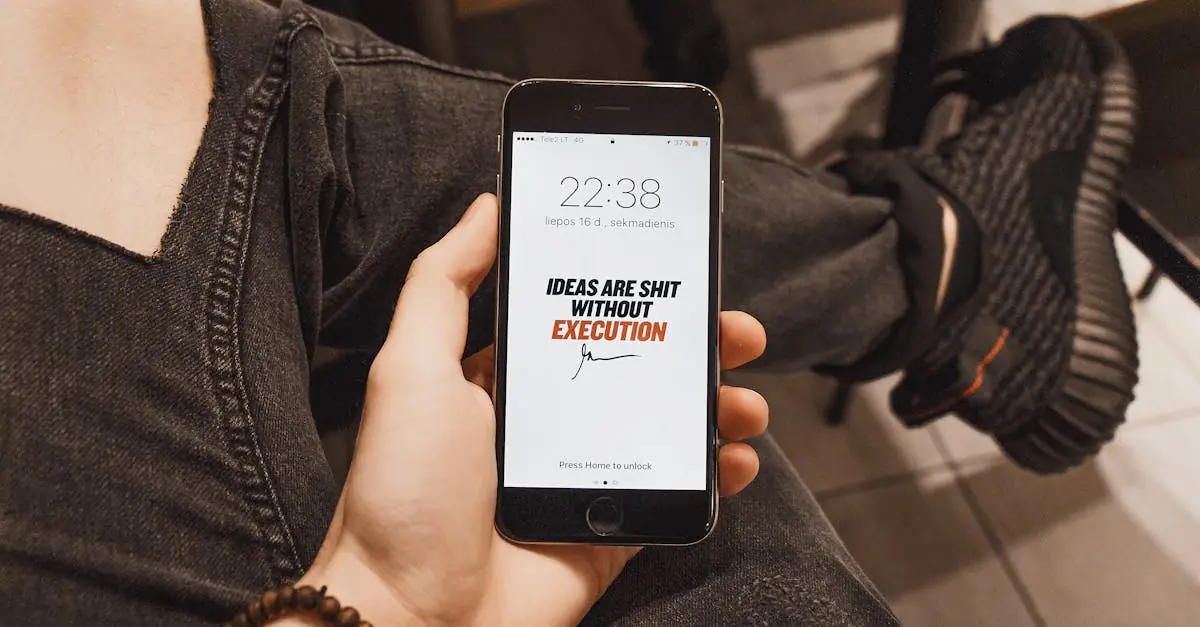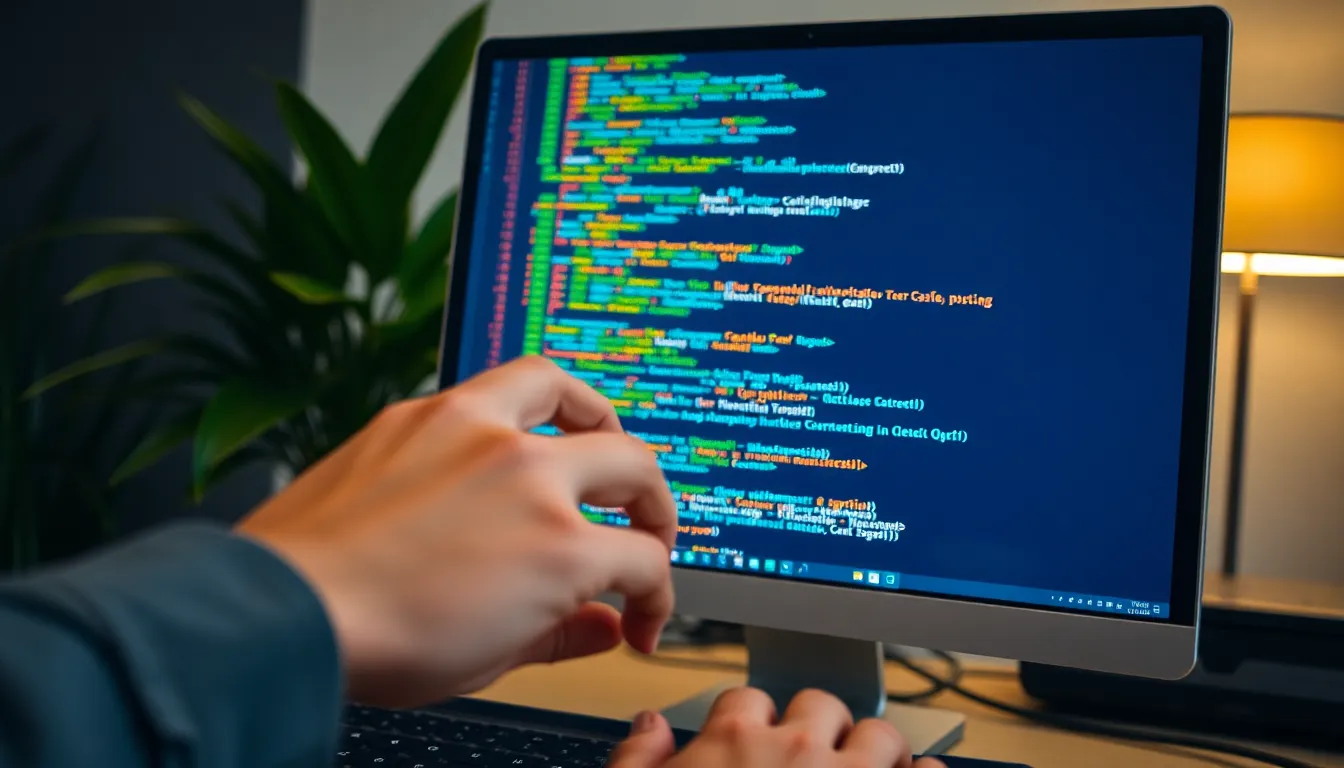Table of Contents
ToggleStumbling upon a locked iPhone can feel like finding a treasure chest with no key. It’s shiny, it’s sleek, and it’s practically begging to be unlocked. But before you start channeling your inner tech wizard, it’s essential to know the right steps to take. After all, no one wants to be the accidental villain in a smartphone saga.
Instead of trying to crack the code like a modern-day Sherlock Holmes, there’s a better way to handle this situation. Whether it’s a lost device or a forgotten gadget, knowing what to do can save you from a world of trouble. So, let’s dive into the smart and responsible ways to return that locked iPhone to its rightful owner without turning into a tech-savvy detective.
Understanding Locked iPhones
Locked iPhones restrict access to their features and data without the owner’s passcode. Encountering a locked device can create confusion regarding the right steps to take. Apple’s design prioritizes user security, making unauthorized access virtually impossible.
Many individuals wonder if they can crack the passcode or reset the device. Attempting to bypass security measures not only violates Apple’s terms of service but can lead to legal repercussions as well. Instead of trying to unlock the phone, focus on more constructive solutions that respect the owner’s privacy and security.
Returning a locked iPhone to its owner should be the priority. If it’s found in a public area, consider handing it to a nearby establishment, such as a coffee shop or a police station. These locations often assist in finding the rightful owner using lost and found procedures.
Using Apple’s built-in features can facilitate the return process. Owners can set up a custom message on their locked screens that provides contact information. This message can help you connect with them directly.
If the owner cannot be identified, it’s advisable to take the device to a local Apple Store. Technicians may offer assistance in locating the rightful owner. They possess resources and channels for reporting lost devices.
Being a responsible finder helps in maintaining community trust. Following proper protocols when encountering a locked iPhone ensures that individuals respect others’ privacy. Engaging in ethical practices benefits everyone involved, paving the way for smooth resolutions.
Immediate Steps to Take
Finding a locked iPhone requires immediate and thoughtful action. Ensuring the device reaches its rightful owner minimizes stress for everyone involved.
Assess the Situation
First, determine the location where the iPhone was found. If the device is in a public place like a café or park, it might be easier for the owner to return and reclaim it. Next, check if anyone nearby is looking for a missing phone. Asking individuals in the vicinity can help identify the owner quickly. Consider the condition of the phone as well; visible damage might indicate a struggle or accident. Always remain in the area for a short while in case the owner returns seeking their device. Taking these steps lowers the chances of someone losing their phone permanently.
Check for Ownership Information
Look for any identifying information displayed on the screen. Often, iPhones feature a custom message on the lock screen, providing contact details for the owner. Checking for such messages, if visible, could significantly facilitate the return process. If no messages appear, gently press the side button to wake the screen. Sometimes notifications can reveal more about the owner. Avoid attempting to unlock or access personal data, as this compromises privacy and can lead to legal issues. In the absence of overt ownership information, consider leaving the phone with a nearby establishment, or if necessary, take it to a police station for safe handling.
Contacting the Owner
Finding a locked iPhone can be perplexing, but reaching out to the owner is essential. Several options exist for facilitating this process.
Social Media and Networking
Using social media can aid in connecting with the owner. Posting on platforms such as Facebook or Twitter can help spread the word. Local groups or community pages often provide a way to reach a larger audience. Include clear details about the phone’s appearance and location when posting. Tagging local neighborhoods or community pages increases visibility, enhancing the chances of finding the owner quickly.
Local Lost and Found Services
Local lost and found services serve as valuable resources for returning lost items. Many communities have dedicated websites or social media pages where finders can report lost items. Contacting local authorities, such as schools or event venues, also proves beneficial. Listings at these locations help ensure the owner receives the information needed to reclaim their device. Taking the time to report the find contributes to a positive community environment and promotes responsible behavior among finders.
Visiting Apple Support
When finding a locked iPhone, visiting Apple Support provides a secure option for returning the device. Apple experts offer guidance in navigating the situation effectively.
Booking an Appointment
To initiate the process, booking an appointment through the Apple Support website or the Apple Support app is essential. Select a convenient time and location, and ensure an employee will assist with the device. Consider checking availability for walk-in appointments, though scheduling ahead often reduces wait time. Also, gather any relevant information to present to the staff for efficient service.
What to Expect at Apple Store
At the Apple Store, representatives will assist in verifying the device’s ownership if possible. They’ll check for any identifying information linked to the phone. Expect a discussion about the next steps to locate the owner, including potentially contacting the original owner directly. In case no ownership can be established, the staff may keep the device secure until the owner comes forward.
Legal Considerations
Finding a locked iPhone raises important legal considerations. Firstly, attempting to unlock the device constitutes unauthorized access, which violates both Apple’s terms of service and laws regarding computer crimes. Engaging in such actions may lead to criminal charges, which can have serious repercussions.
Local laws vary regarding lost property. Legally, finders often have a responsibility to return lost items to their rightful owners or to authorities. In many jurisdictions, keeping a found device without taking proper steps to return it can be considered theft. Reporting the find to local authorities, such as a police station, often serves as the best course of action.
Possessing a locked iPhone could lead to privacy breaches. Accessing its data, even inadvertently, can expose sensitive personal information. This highlights why contacting an authorized outlet or law enforcement is prudent. Both entities can provide guidance on the next steps while safeguarding the owner’s privacy.
It is crucial to understand that Apple maintains strict protocols for device ownership verification. While Apple Store staff will assist in the return process, they can only help after confirming ownership. For this reason, individuals should not attempt to bypass these methods.
Ethical considerations in handling a locked iPhone focus on respect for privacy and adherence to legal requirements. Properly addressing the find fosters a trustworthy community and ensures that all actions remain within the law. Following the outlined steps helps mitigate potential legal issues while respecting the rights of the device’s owner.
Finding a locked iPhone can be a challenging situation but acting responsibly is crucial. By following the recommended steps to return the device to its owner, individuals contribute to a sense of community and trust. Utilizing local resources and social media can significantly enhance the chances of reuniting the phone with its rightful owner.
It’s essential to respect privacy and adhere to legal guidelines throughout the process. Whether handing the phone to a nearby establishment or contacting Apple Support, each action taken should prioritize the owner’s rights. Ultimately, fostering a culture of integrity ensures a smoother resolution for everyone involved.





